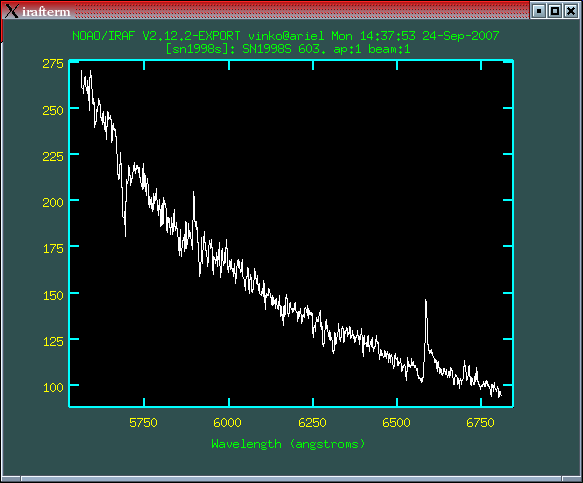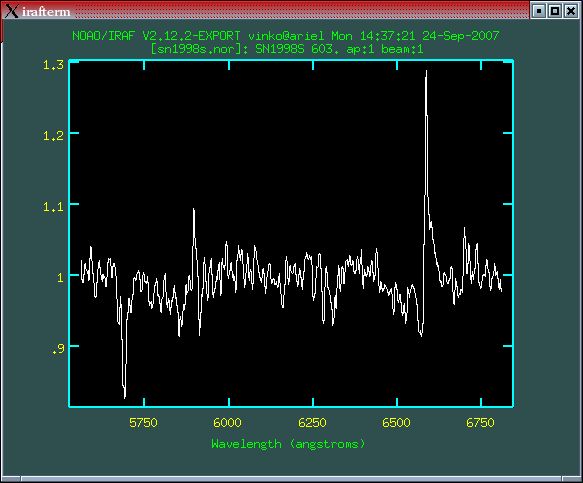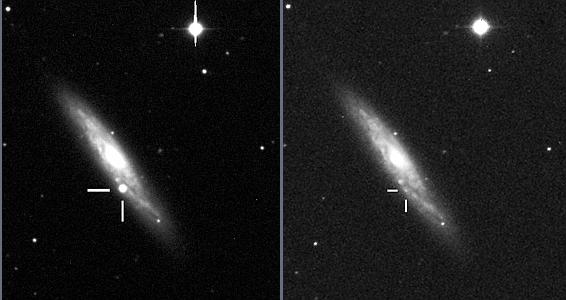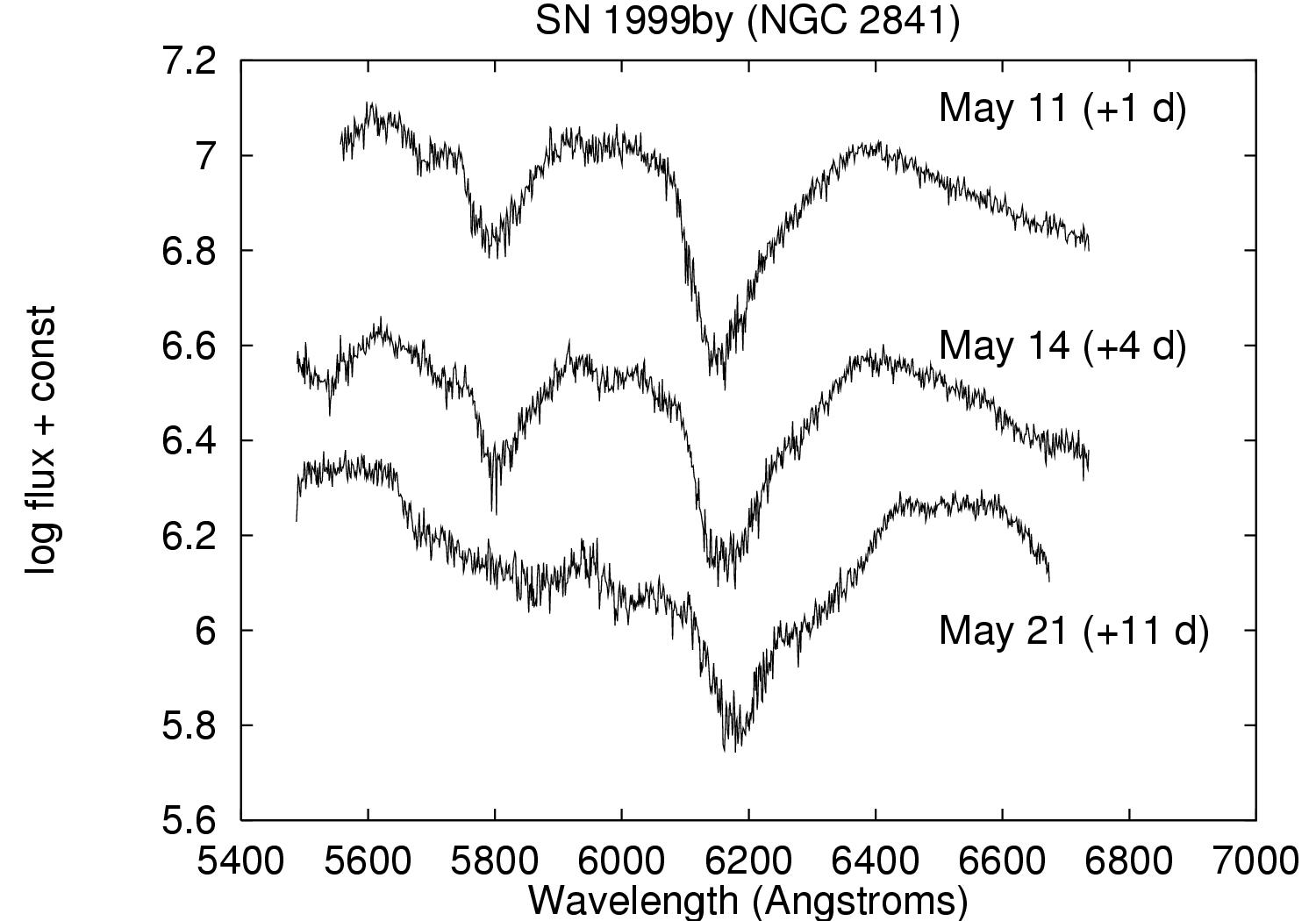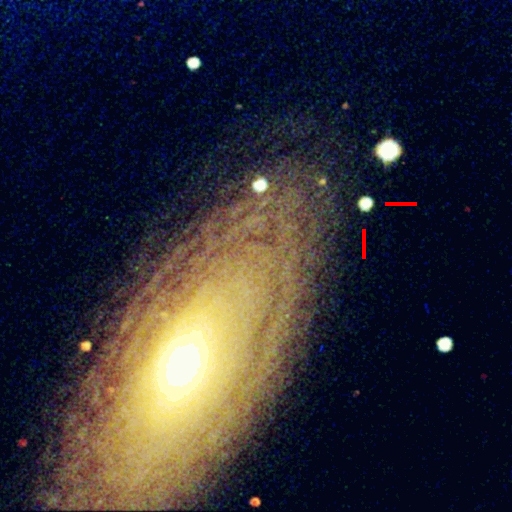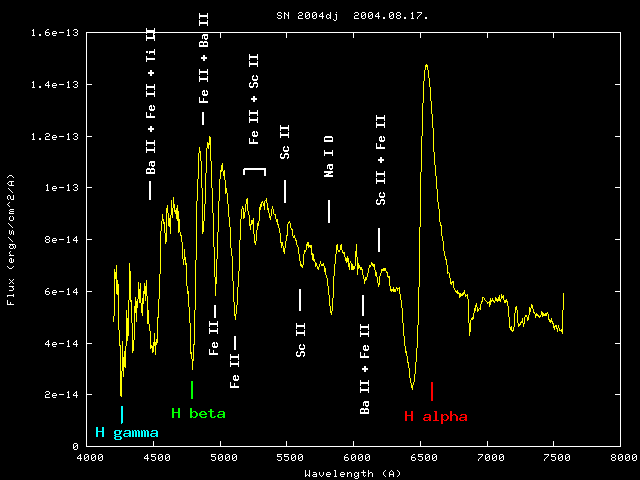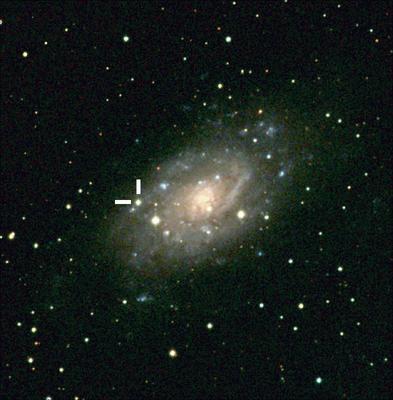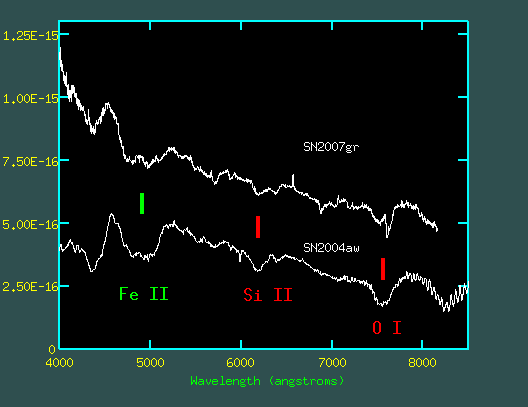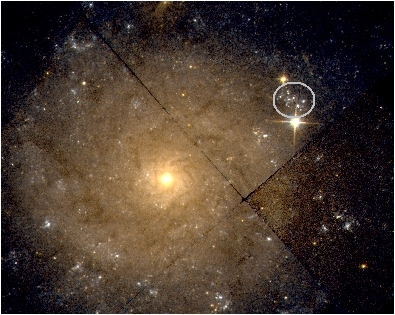Spectroscopy
of Bright Supernovae at DDO
Jozsef Vinko
Department of Optics & Quantum Electronics, University of
Szeged, Hungary
Introduction
Supernovae (SNe)
are exploding stars, which appear practically randomly in space and
time. The number of discovered SNe per year has been constantly
increasing over the last decade. Some of the brightest SNe have been
succesfully observed with the DDO 1.88" telescope and Cassegrain
spectrograph, both in medium- and low-resolution mode. At DDO, SNe are observed as
a Target-of-Opportunity (ToO) program with the approval both from the
director and the scheduled observer. This web page describes the
past and present SNe observations made at DDO and gives the references
of the publications based on these data.
SN 1998S (NGC 3877)
This SN was discovered on March 2.68, 1998 by Z. Wan. On March 16,
1998, shortly after discovery, Mike Gladders and Jim Thomson took a
single spectrum of the SN, 'just for curiousity' as Jim often said,
with the 150A grating in 2nd order, centered on 6000 Angstroms. The
observed spectrum can be seen in Fig.1 (left panel) showing the hot,
blue continuum. In the right panel, the continuum-normalized spectrum,
enhancing the visibility of the H-alpha line, is presented. This SN
turned out to be a IIn-type one, which is illustrated very well by the
narrow H-alpha emission peak superimposed on a broader, but fainter P
Cygni - profile. These SNe are thought to explode within a dense
circumstellar medium (CSM), and the strong, narrow H-alpha emission
during the early phases is formed when the CSM is heated and excited by
the SN ejecta.
Fig.1.
Left panel: observed spectrum of SN 1998 S. Right panel:
contimuum-normalized spectrum
Fig.2.
SN 1998S in NGC 3877 from Konkoly Observatory, Hungary
Fig.2 shows the location of SN 1998S in its host galaxy. NGC 3877 is a
highly inclined Sc-type galaxy. SN 1998S occured in an outer spiral
arm, where Type II SNe are usually found. The left image shows the
galaxy plus the SN roughly one month after explosion, while the right
image was made in Nov. 1998, more than 200 days after explosion. The
position of the SN is marked. These CCD images were taken by Laszlo L.
Kiss with the 90-cm Schmidt telescope at Konkoly Observatory, Hungary.
SN 1998aq (NGC 3982)
SN 1998aq was discovered by M. Armstrong on April 13, 1998, very
shortly after explosion. It turned out to be a Type Ia SN, an exploding
white dwarf in a binary system. SN 1998aq reached its maximum
brightness on April 29, 1998.
Three spectra of this event have been obtained at DDO by Jim Thomson,
Wen Lu, Stefan Mochnacki and Tom Bolton on April 22 (7 days before
maximum), May 8 (9 days post-maximum) and May 27 (28 days post-maximum)
using the same setup as for SN 1998S. Fig.3 displays the three spectra.
In the first two spectra the strongest absorption feature at 6150 A is
the Si II transition, the characteristics of Type Ia SNe. This SN
evolved fast, as usual for Type Ia SNe: on the third spectrum, one
month after maximum, the Si II absorption is engulfed by the broad Fe
II and [Fe III] emission around 6500 A.
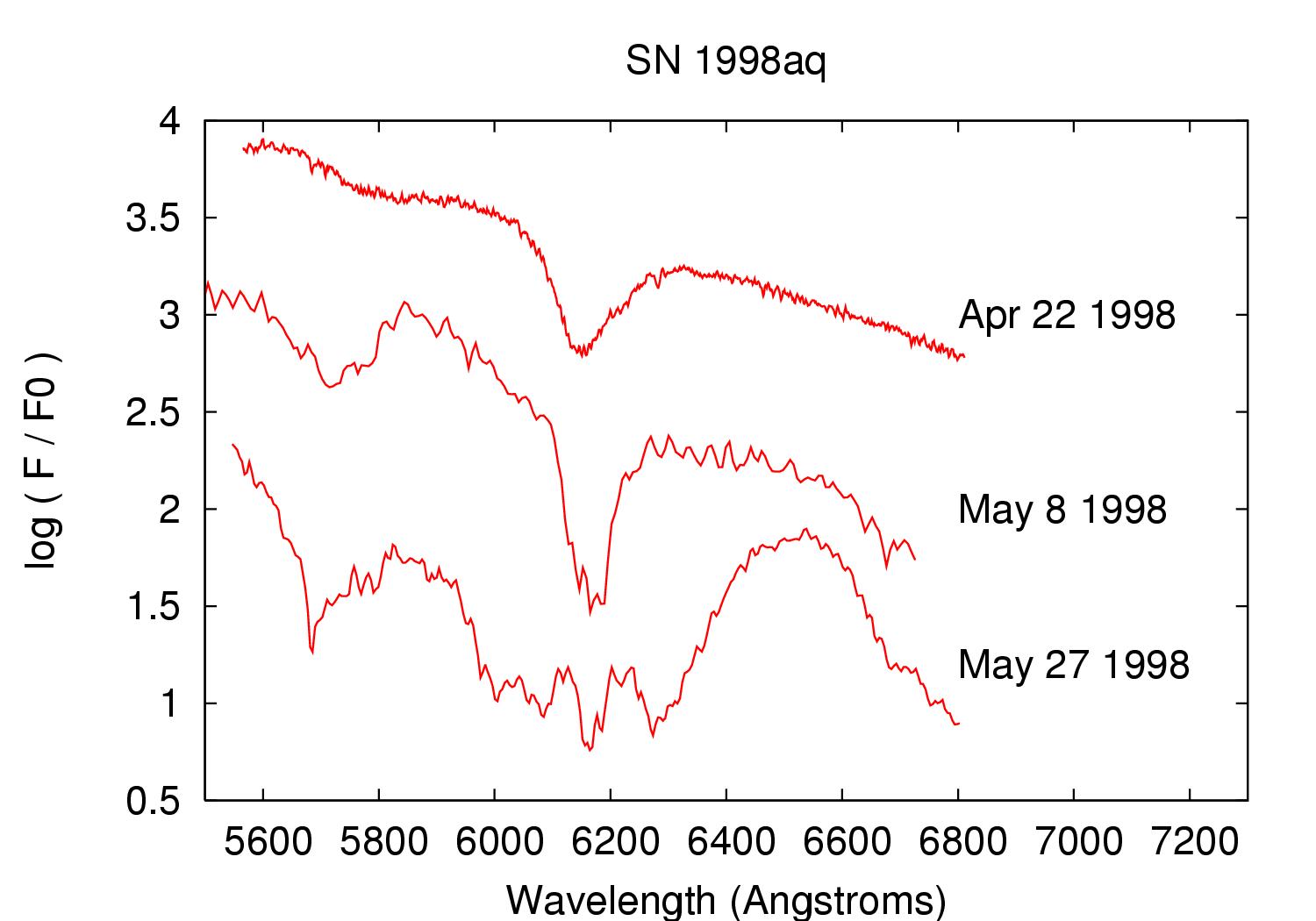 Fig.3.
Fig.3. Spectra of the Type Ia
SN 1998aq in NGC 3982.
Vinkó et al. (1999) measured the line depth ratio of the
Si II transitions at 5800 A and 6150 A, R = 0.22 +/- 0.02 based on the
first DDO spectrum. This parameter correlates with the intrinsic
luminosity of SNe Ia. From this single epoch measurement a
distance of d = 15.1 +/- 4.4
Mpc has been calculated. The Cepheid distance to the host galaxy is d = 21 +/- 3 Mpc (Stetson &
Gibson 2001; Saha et al. 2001; Riess et al. 2005).
SN 1999by (NGC 2841)
SN 1999by was discovered independently by R. Arbour, E. Berkó
and LOSS on April 28.8, 1999. It was observed at DDO by Stefan
Mochnacki, Laszlo L. Kiss and Jim Thomson on May 11, 14 and 21, 1999.
The three spectra are plotted in Fig.4 (left panel). This SN is turned
out to be a subluminous Type Ia event, similar to SN 1991bg, which is
characterized by the relatively strong absorption through at 5800 A,
beside the deep Si II line at 6150 A (Vinkó et al., 2001;
Garnavich et al. 2004).
Fig.4.
Left panel: Spectra of SN 1999by obtained at DDO. Right panel: The
optical image of SN 1999by in NGC 2841.
The right panel in Fig.4 shows the location of SN 1999by in NGC 2841.
This
color-composite image (red: Cousins I, green: Johnson V, blue: Johnson
B) was made by Róbert Szabó with the 1-m RCC telescope of
Konkoly
Observatory, Hungary on May 21, 1999. The red lines point to the SN.
SN 2002ap (M 74 = NGC 628)
This SN was discovered by Y.Hirose on Jan. 29, 2002, well before
maximum. Between Feb.2 and Feb. 25, 2002, 7 spectra were collected at
DDO by Mel Blake, Jim Thomson, Heide DeBond and Stefan Mochnacki with
the Cassegrain spectrograph, applying the new 100H grating. This new
low-dispersion grating enabled us to get high S/N low-resolution
spectra covering the whole visible spectral range (4000 - 8000 A). SN
2002ap turned out to be a very interesting event, sometimes called
"hypernova". Its first DDO spectrum is plotted in Fig.5 (left panel)
with some spectral features identified. The term "hypernova" refers to
the very broad spectral lines, implying expansion velocities as high as
30,000 km/s. Many of such SNe are connected with GRBs, such as SN
1998bw/GRB 980425. In spite of that, SN 2002ap was associated with no
recorded GRB.
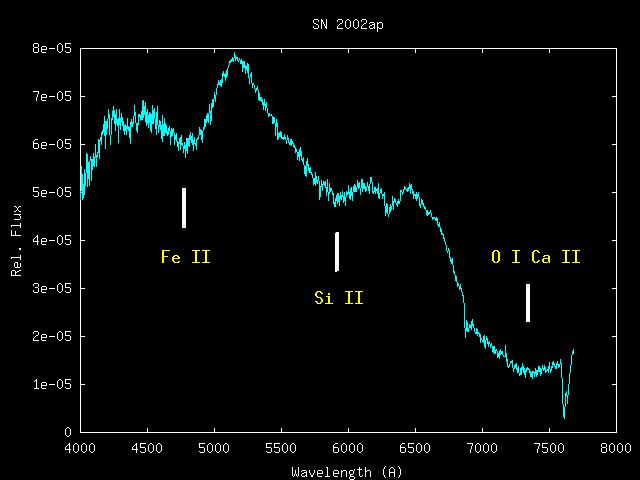 |
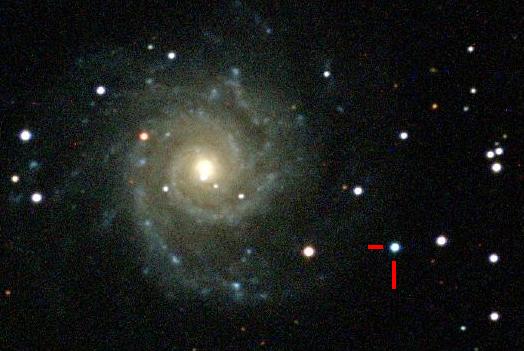 |
Fig.
5. Left panel: DDO spectrum of SN 2002ap taken on Feb.2, 2002.
Right panel: The position of SN 2002ap in M74 (imaged by K.
Sárneczky).
The right panel in Fig. 5 shows SN
2002ap in M74 near maximum light. It is apparent that the SN is very
blue compared with some nearby field stars. This image was obtained by
K. Sárneczky with the 90-cm Schmidt telescope at Konkoly
Observatory.
Detailed analysis of this SN has been published by Vinkó et al.
(2004) based on the data obtained at DDO and other observatories. The
spectral evolution of this peculiar Type Ic SN is summarized in Fig.6,
where the DDO spectra (red), and spectra from Wise Observatory (green;
Gal-Yam et al., 2002) are plotted for comparison. Such SNe are thought
to originate from the explosion of a Wolf-Rayet star, practically a
stripped stellar core that lost most of its H-rich envelope prior to
explosion. This is why there are no hydrogen lines in the spectra. The
very broad lines may be due to an asymmetric explosion, where the
high-velocity jet is pointing nearly to the line-of-sight, producing
much higher velocities than in ordinary SNe.
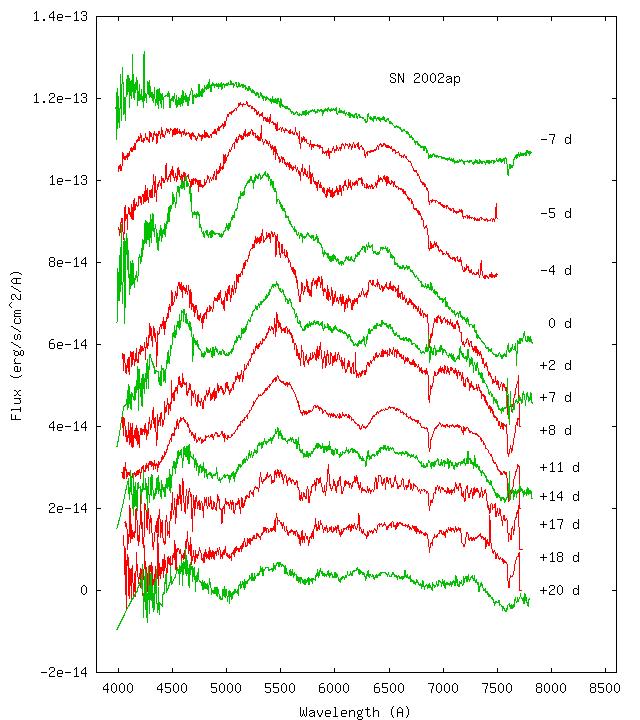
Fig. 6. Spectral evolution of SN 2002ap from data obtained at
DDO (red) and Wise Obs. (green).
SN 2004dj (NGC 2403)
This bright, nearby SN was discovered by Itagaki on July 31, 2004. Soon
after discovery, several spectra were obtained at DDO, starting from
Aug. 17, 2004. Unfortunately, this Type II-P SN was discovered ~50 days
after explosion, so the early-time spectra could not been studied.
However, it was the brightest SN observed since SN 1987A, so its
spectral evolution could be followed well into the nebular phase. The
observations at DDO were continuing up to Nov. 14, 2004, ~140 days
after explosion. The observers were Heide DeBond, Jason Grunhut, Jim
Thomson, Stefan Mochnacki and Tuba Koktay.
In Fig.7 (left panel) the spectrum obtained on Aug.17, 2004 is plotted
together with the identified spectral features. This is a textbook
example of a Type II-P SN, a supergiant star with M > 8 solar mass,
exploding after the gravitational collapse of its iron core (the letter
"P" in the type refers to a constant luminosity "plateau" in the light
curve). The most prominent lines are due to the Balmer-series of
hydrogen, and several other metallic lines (mostly Fe II) are present.
The right panel shows the position of the SN in one of the outer spiral
arms of NGC 2403 (this image was made by K. Sárneczky with the
90-cm Schmidt telescope of Konkoly Obs. on Aug.8, 2004).
Fig.7. Left panel: Photospheric-phase spectrum of SN 2004dj
observed at DDO on Aug.17, 2004. Right panel: SN 2004dj in NGC 2403
(from Konkoly Obs.).
In Fig.8 the last DDO spectrum (made on Nov.14, 2004) is plotted. This
is a typical late-time spectrum of a SN that cooled and became
optically thin due to the expansion. The spectrum is dominated by
bright emission lines of H-alpha, Na D and several other other
permitted and forbidden transitions of metals, mostly Fe.
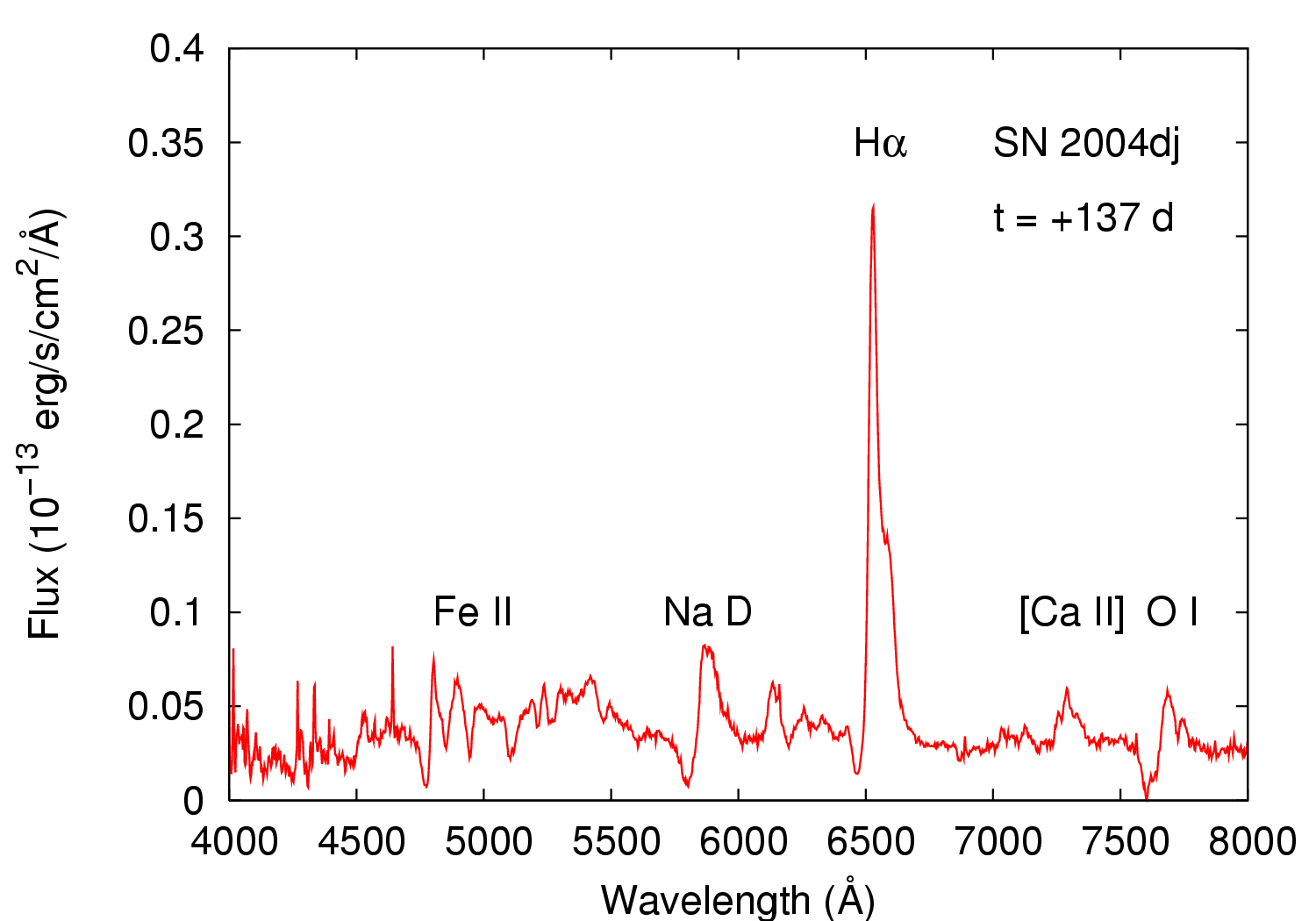 Fig.8.
Fig.8. A nebular spectrum of SN
2004dj obtained at DDO.
Combining the DDO spectra with photometric data from other
observatories, we derived the distance to the host galaxy NGC 2403 as d = 3.5 Mpc by applying the
Expanding Photosphere Method. Details of this analysis can be found in
Vinkó et al. (2006).
This SN is particularly interesting, because its progenitor star was a
member of a young compact stellar cluster, called Sandage-96, within
NGC 2403. Pre-explosion photometry of this cluster and the analysis of
its spectral energy distribution allowed us to determine the age of the
cluster, providing tight constraint on the mass of the exploding star.
The cluster age turned out to be very young, between 8 - 20 Myrs,
resulting in the mass of the progenitor star M ~ 20 solar masses. This
may be the most massive SN progenitor measured up to now.
SN 2007gr (NGC 1058)
This was the first SN brightening up to 13 mag in 2007. It was
discovered by LOSS (CBET 1034) on Aug.15.51, 2007. Because of two
bright foreground stars very nearby (~2 arcsec), the observation of
this SN is difficult. Nevertheless, Heide DeBond and Danny
Wallbank took three spectra on Aug.16 and Aug 17, just after discovery!
Meantime, SN 2007gr was classified as aType Ib/c by Chornock et al.
(CBET 1036) caught very shortly after explosion. Later, this
classification was refined by Crockett et al. (2007) as a peculiar Type
Ic.
Fig. 9 (left panel) shows the similarity between the spectrum of SN
2007gr (Aug.17, 2007, DDO) and SN 2004aw (Taubenberger et al. 2006),
another peculiar Type Ic. Similar spectral features appear in both
spectra, although the line shapes are slightly different. Hydrogen is
absent, so does Helium, that's why the type is Ic. Si II is present,
but weak. There is a narrow emission near 6570 A that can be attributed
to H-alpha from an underlying H II area (W. Li, personal
communication). The spectral appearance of SN 2007gr suggests a very
early photospheric phase of a Type Ic SN.
Fig.
9. Left panel: Optical spectra of SN 2007gr (DDO) and SN 2004aw
(Taubenberger et al. 2006).
Right panel: Pre-explosion image of NGC 1058 taken with HST WFPC2 (P.I.
S.Smartt; Crockett et al. 2007). SN 2007gr occured within the encircled
region.
The right panel of Fig.9 displays the host galaxy, NGC 1058, imaged
with the HST WFPC2 camera on July 3, 2001 (P.I. S.Smartt), downloaded
from the HST archive at Canadian Astronomy Data Centre (CADC). SN
2007gr occured within the encircled region (between the two bright
field stars) containing several resolved point sources. These are young
massive stellar clusters (Crockett et al. 2007). The monitoring of SN
2007gr combined with pre-explosion data could provide unprecedented
information on the progenitor and the explosion of Ic SNe. Collecting
more spectra of this SN at DDO is underway.
References
Crockett,
R.M., Maund, J.R., Smartt, S.J. et al. 2007 astro-ph 0709.2354
Gal-Yam,
A., Ofek, E.O., Shemmer, O. 2002 MNRAS 332, L73
Garnavich,
P.M., Bonanos, A.Z., Jha, S. et al. 2004, ApJ 613, 1120
Riess,
A.G., Li, W., Stetson,P.B., Filippenko, A.V., Jha, S., Kirshner, R.P.,
Challis, P.M., Garnavich, P.M., Chornock, R. 2005, ApJ 627, 579
Saha, A.,
Sandage, A., Tammann, G.A., Dolphin, A.E., Christensen, J., Panagia,
N., Macchetto, F.D. 2001, ApJ 562, 314
Stetson,
P.B., Gibson, B.K. 2001, MNRAS 328, L1
Taubenberger,
S. et al. 2006, MNRAS 371, 1459
Vinkó,
J., Kiss, L.L., Thomson, J.R., Fűrész, G., Lu, W.,
Kaszás, G., Balog, Z. 1999 A&A 345, 592
Vinkó,
J., Blake, R.M., Sárneczky, K. et al. 2004, A&A 427, 435
Vinkó,
J., Takáts, K., Sárneczky, K. et al. 2006, MNRAS 369, 1780
